As a daily practice, the first thing I do with my New York Times is take a look at the top of page three in the A section. There, every day, a Tiffany & Co. ad appears in the top right-hand corner, right next to a lede international story.
Tiffany has been an advertiser in the Times since the 1920s, and over time, has come to “own” that particular piece of real estate. They seem to maintain a limited range of ads which change seasonally, and these are rotated with a few new ones thrown in for special occasions: holidays, the new Frank Gehry line, etc.
I never paid much attention to this space until the fall of 1991, when I went to see a group show at the New Museum entitled “The Interrupted Life,” in which artist Laura Fields contributed a piece titled Child’s Play that still resonates in my head to this day. It consisted of a New York Times page three, framed, with the glass darkened everywhere except over the international story — headline of “Remembering a Tortured Child Who Lived in the Streets of Guatemala City” — and the Tiffany ad — for a silver baby rattle, headlined “Child’s Play.” Beneath the piece, as a pendant, Fields displayed the rattle in a wooden box.
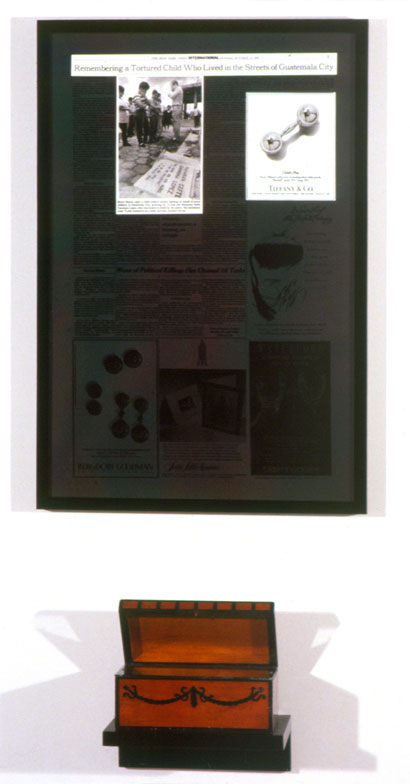
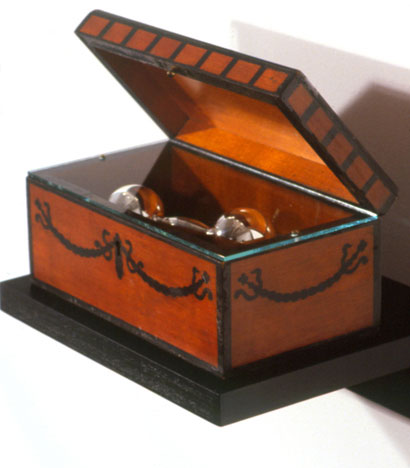
The collision of rich baby/poor baby is the kind of random, but charged, occurrence which captured the attention of many artists working from the late 1970s to the early 1990s. Today the galleries are full of either doodles or porn, but back then you could count on seeing some kind of media appropriation or commodity critique. It was the time of the seminal “Pictures” exhibition and a time under the influence of critic John Berger.
In his BBC television series and companion book Ways of Seeing, Berger built upon the work of Walter Benjamin and Roland Barthes while describing the collision of advertising and news images in popular media.
The entire world becomes a setting for the fulfillment of publicity’s promise of the good life. The world smiles at us. It offers itself to us. And because everywhere is imagined as offering itself to us, everywhere is more or less the same. The contrast between publicity’s interpretation of the world and the world’s actual condition is a very stark one, and this sometimes becomes evident in the color magazines which deal with news stories.
(snip…)
The shock of such contrasts is considerable: not only because of the coexistence of the two worlds shown, but also because of the cynicism of the culture which shows them one above the other. It can be argued that the juxtaposition of images was not planned. Nevertheless the text, the photographs taken in Pakistan, the photographs taken for the advertisements, the editing of the magazine, the layout of the publicity, the printing of both, the fact that advertiser’s pages and news pages cannot be co-ordinated — all these are produced by the same culture.
It is not, however, the moral shock of the contrast which needs emphasizing. Advertisers themselves can take account of the shock. The Advertisers Weekly (3 March 1972) reports that some publicity firms, now aware of the commercial danger of such unfortunate juxtapositions in new magazines, are deciding to use less brash, more somber images, often in black and white rather than color. What we need to realize is what such contrasts reveal about the nature of publicity.
Publicity is essentially eventless. It extends just as far as nothing else is happening. For publicity all real events are exceptional and happen only to strangers. In the BanglaDesh photographs, the events were tragic and distant. But the contrast would have been no less stark if they had been events near at hand in Derry or Birmingham. Nor is the contrast necessarily dependent upon the events being tragic. If they are tragic, their tragedy alerts our moral sense to the contrast. Yet if the events were joyous and if they were photographed in a direct and unstereotyped way the contrast would be just as great.
Publicity, situated in a future continually deferred, excludes the present and so eliminates all becoming, all development. Experience is impossible within it. All that happens, happens outside it.
The fact that publicity is eventless would be immediately obvious if it did not use a language which makes of tangibility an event in itself. Everything publicity shows is there awaiting acquisition. The act of acquiring has taken the place of all other actions, the sense of having has obliterated all other senses.
—Berger, Ways of Seeing
My early exposure to this “way of seeing” was first viewing the BBC series as a freshman in college, and then as a junior designer in New York. Even though they didn’t speak the language of intertextuality, the art directors above me often would tweak layouts whether one image was “looking” at an image across from it or not. And from that moment on, inspired, I began collecting magazine covers based on their overall narrative effect.
So ever since seeing Child’s Play, I’ve looked at page three of the New York Times differently: always looking for a correspondence between the narratives of news photo and Tiffany ad, a correspondence between text and image, or simply a correspondence of shapes.
It’s become a daily observation exercise and a daily affirmation of the artists, critics and essayists whose work I loved as a young designer and who — whether they knew it or not — affect my daily outlook.
As a way to convey either how easy it is to make connections, or how frequently such combinations occur, here are thirty examples collected over the past year:
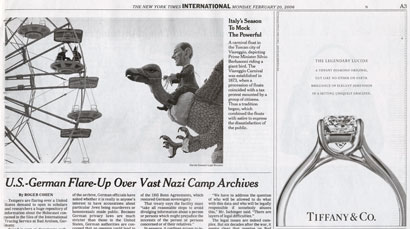
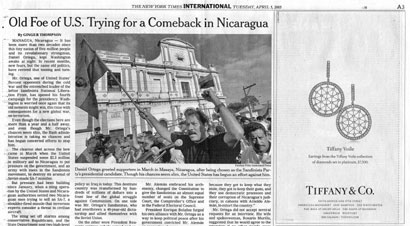
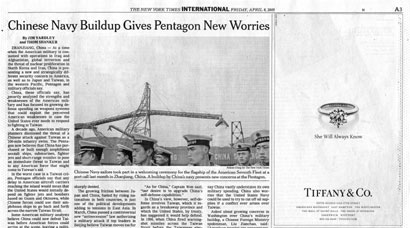
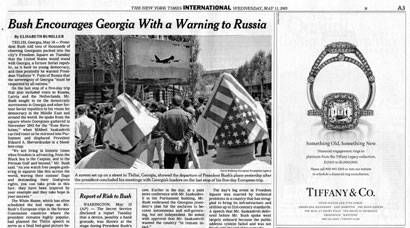
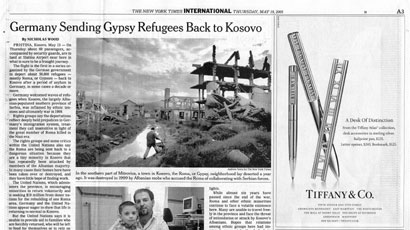
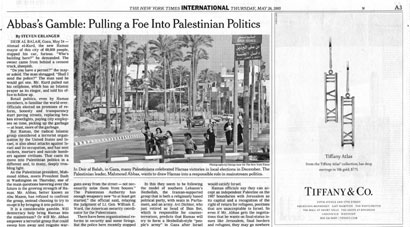
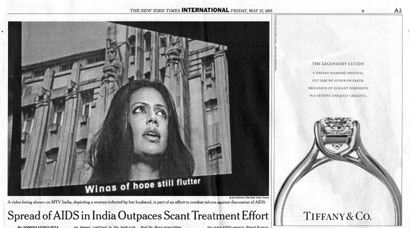
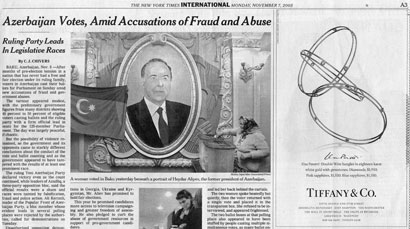
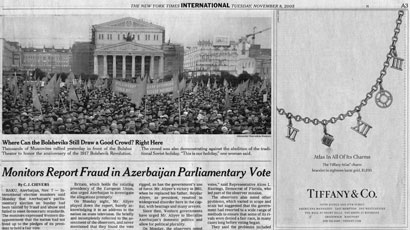
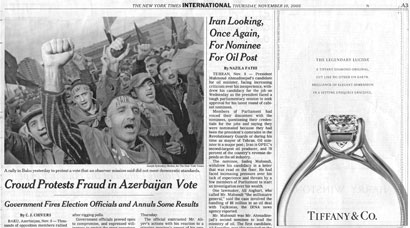
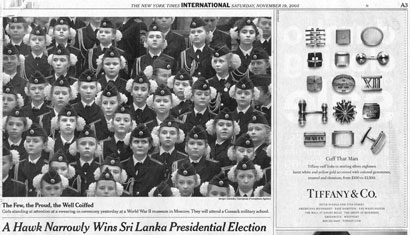
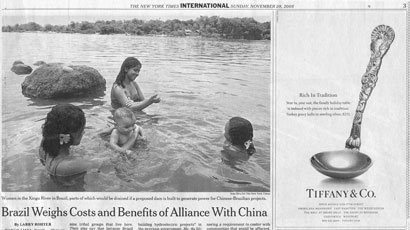
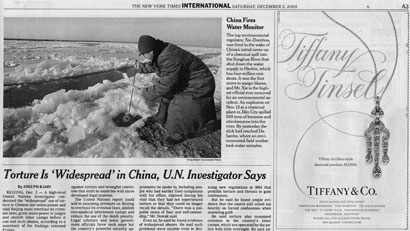
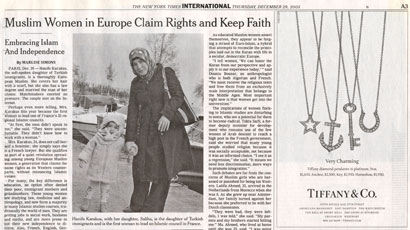

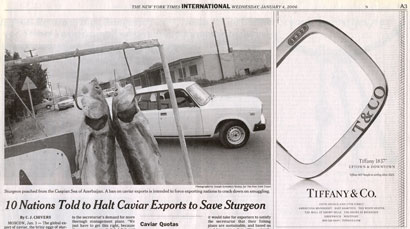
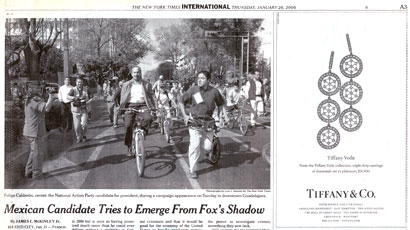
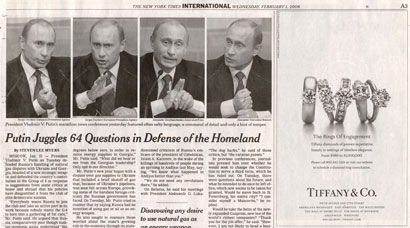
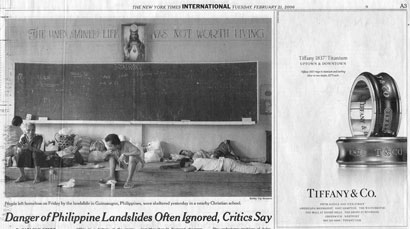
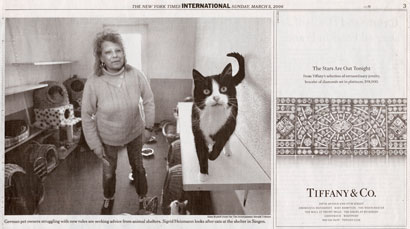
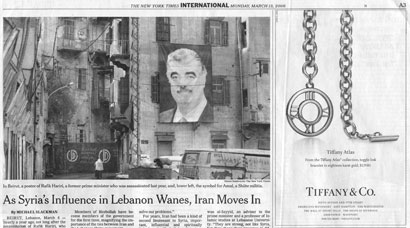

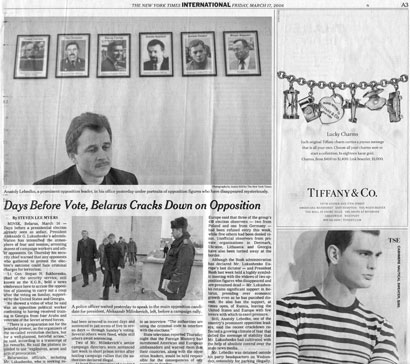
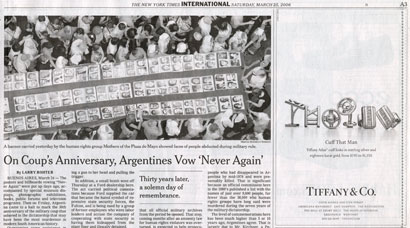
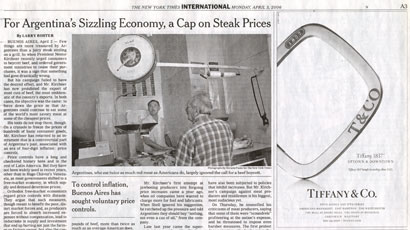
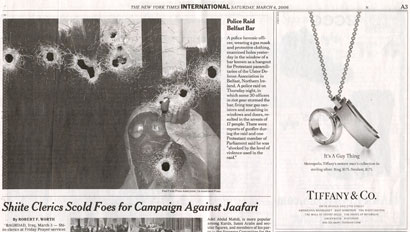
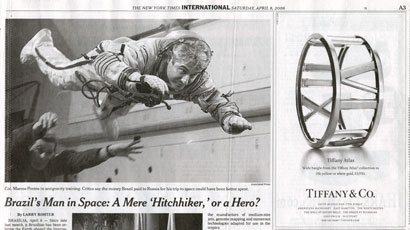
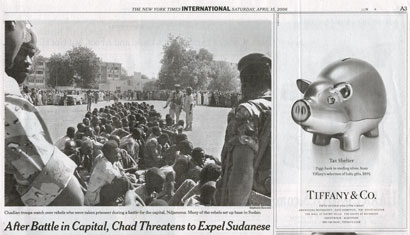
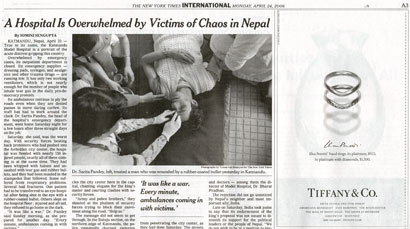
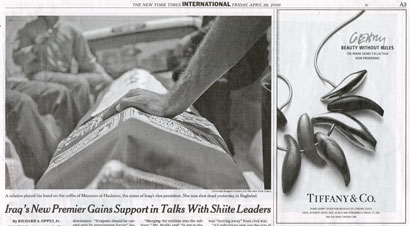
One doesn’t have to read the New York Times to engage in this exercise. For example, I often find myself looking at street snipes the same way I do page three.
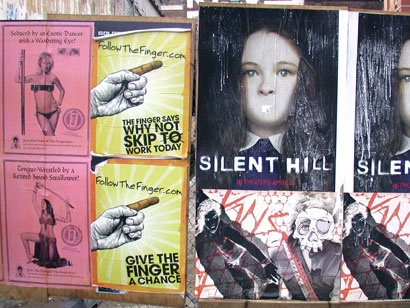
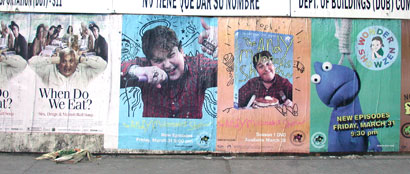
As I mentioned earlier, this way of seeing the world — and the world of images — was “in the air” and continues to this day. One of the more notable John Berger followers is Lawrence Weschler, who’s most recent book, Everything That Rises: A Book of Convergences, follows a similar path — there’s even a convergence of convergences contest on the McSweeney’s site.
Besides the continual presence of this observational strategy, one final point remains to be addressed. And that is the issue of Ross Bleckner’s claims to the page three phenomena.
In 1993, two years after “The Interrupted Life” exhibition, Robin Kahn edited a collection of artist projects for Mimi Somerby, S.O.S. Int’l and B.R.A.T., an Arts Organization called Promotional Copy. On page 44, Laura Fields contributed a page three convergence entitled Baby Elephant, which paired an image of a starving Sudanese girl and waiting vulture against an ad for a sterling silver elephant figurine.
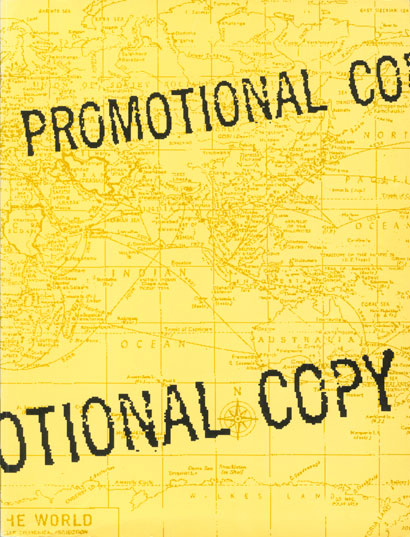
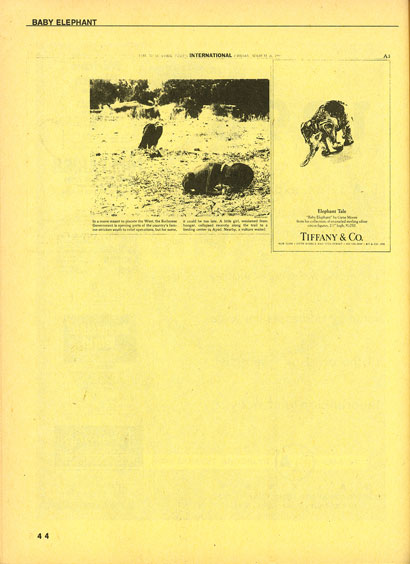
Also in 1993, Bleckner contributed a project to the contemporary art magazine, Parkett, entitled Tiffany’s. It also appeared on page 44 — some convergence! — and also featured the Sudanese girl/vulture/silver elephant image.
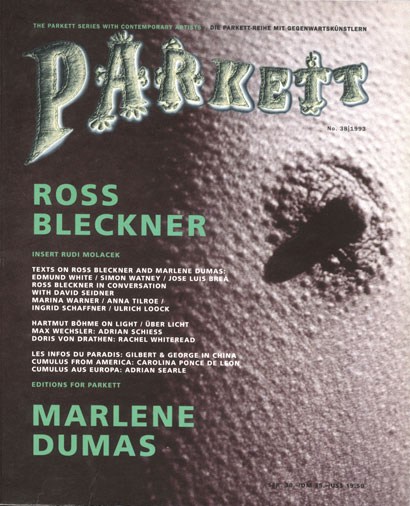
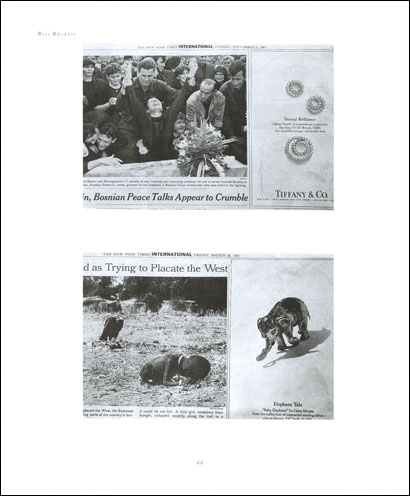
Twin Palms published Bleckner’s book Page Three in 1998 and in 2000, the Checkerboard Film Foundation released director Barbara Wolf’s film Ross Bleckner: Remember Me; in which there’s a sequence of him flipping through the Times and, again, meditating on page three.
Fact is, Bleckner has gotten a lot of mileage out of Laura Field’s initial observation. Yet I’m not making this point to spite him — actually, I adore his work. But we need to correctly give credit where credit is due.
Artist Victor Hsieh once asked asked Bleckner about his piece Remember Me; to which he responded: “That’s what all artists whisper beneath their work. It’s a mark you make that you want to leave on the world. It’s what you want to be thought of, and your work represents you. It is you when you’re not you anymore. When you’re gone.”
So in that spirit, I remember Laura Fields. One rarely knows how a passing remark or one piece out of a lifetime of work will affect others. But in the case of her Child’s Play, I think about it every day. It colors how I use images, look at images and see the world in general.
Fields continues to mine meaning from the New York Times. A recent series Bush Erased involves cutting President Bush out of the paper, putting the clippings in a bag and displaying both together.
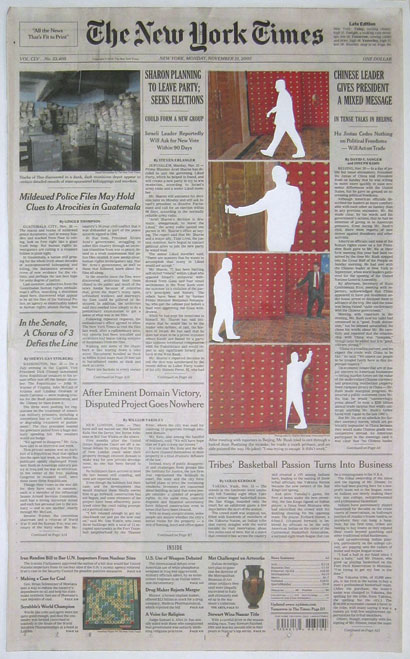
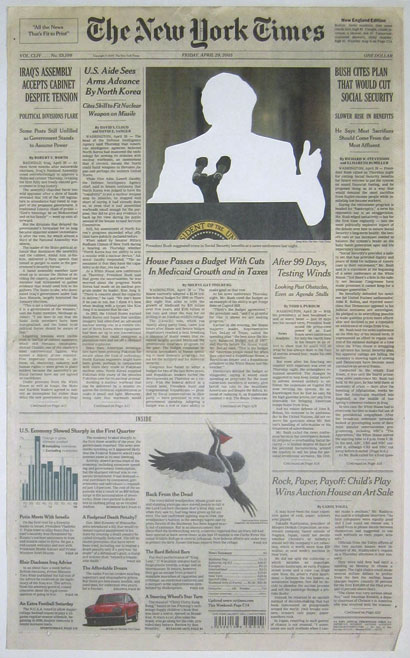
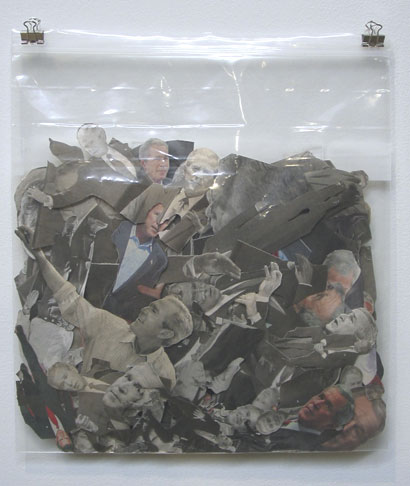
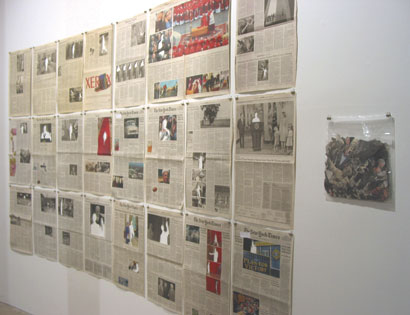
The work has a formal resemblance to John Baldessari but maintains the political edge that drew me to Child’s Play. Fields counters the simplistic language and symbolism of the Bush administration with an equally simple and opposite gesture. And like my “Page Three Sutra,” Bush Erased is a daily visualization exercise: a visualization where the wrongs of the world are erased in hopes of a better future.







Mark, this is the posterchild of M. Kingsley posts. Very amazing.
All of the observations between the international stories and the Tiffany ads is exactly what designers need to do more of these days. While it's evermore easy to create nice-looking things, it seems increasingly harder to see design that is working on more than one level (which is usually the aesthetic level). Design that alludes and connects to other stories that people can interpret based on their experience and knowledge seems something worthy to aspire to. Sorry, this seems to be veering slightly into some other discussion. Anyways, one word: connections.
On May.01.2006 at 09:21 AM